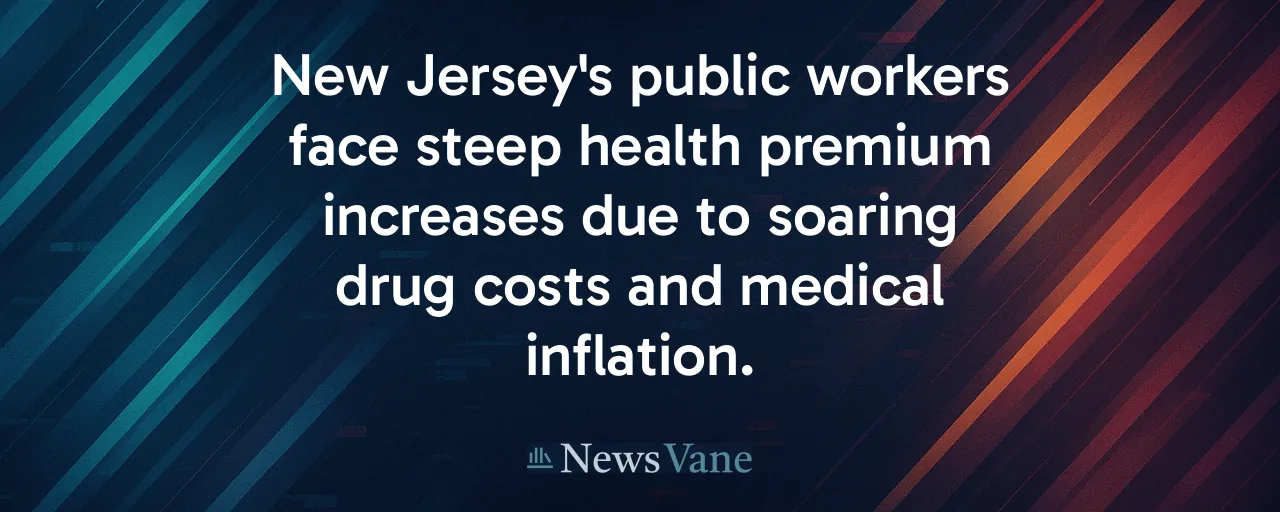A Cost Crisis Hits New Jersey's Public Workers
New Jersey's public employees woke to grim news this week. Actuary AON recommended staggering premium increases for 2026: 36.5 percent for local government workers, 29.7 percent for school employees, and 21 percent for state workers. These hikes, detailed in a July 2025 report, affect nearly 800,000 people covered by the State Health Benefits Program and School Employees' Health Benefits Program. The numbers hit hard, raising questions about how to keep health plans solvent without crushing workers or taxpayers.
The report points to a perfect storm of rising costs. Prescription drugs, especially pricey weight-loss medications like Wegovy, now top the spending charts. Medical inflation and increased demand for complex care add fuel to the fire. For workers, retirees, and local governments, the stakes are high. If approved, these increases could strain household budgets and municipal funds, forcing tough choices.
This issue reflects a longer trend. Over the past five years, premiums for local government plans have more than doubled, climbing 115 percent. School plans jumped 73.9 percent, and state plans rose 67.3 percent. The trend outpaces other public employee plans nationwide, signaling a deeper issue in how New Jersey's health benefits are structured and funded.
Why Costs Are Spiraling Out of Control
Digging into AON's analysis reveals clear culprits. Prescription drug costs are soaring, with drugs like Ozempic and Mounjaro driving a 20 percent annual spending increase. These medications, used for diabetes and weight loss, carry price tags exceeding $10,000 per person yearly. Meanwhile, medical services face 8 percent inflation, compounded by patients seeking more specialized care.
Past losses haunt the plans too. In 2024 and 2025, the state plan racked up $386 million in deficits, while school plans lost $397 million. Local government plans, though smaller, bled $132 million. These shortfalls deplete reserves meant to cushion unexpected costs, forcing higher premiums to rebuild them. Adding to the strain, some low-risk employers are exiting the plans, leaving a sicker, costlier pool of participants.
Plan design plays a role as well. New Jersey's benefits are unusually generous, with actuarial values above 97 percent, meaning plans cover nearly all costs. This encourages higher usage compared to private-sector plans, where cost-sharing like deductibles is common. A 2023 state report noted that few rules guide members toward cost-effective care, amplifying expenses.
A Balancing Act for Workers and Taxpayers
The human impact is real. A 30 percent premium hike could add $600 million to local government budgets, likely raising property taxes. For workers, especially lower-paid school staff, higher contributions could shrink take-home pay. Teachers and public safety workers, already in short supply, might reconsider their careers if benefits erode. Unchecked cost growth risks plan insolvency, threatening coverage for all.
Taxpayers feel the pinch too. Municipalities and school districts, funded partly by property taxes, face trade-offs between health costs and services like road repairs or classroom resources. A 2024 law allowed local plans to borrow $150 million from state reserves. This borrowing provides only a temporary fix. Without reform, experts warn of a 'death spiral' where rising costs drive more employers out, worsening the cycle.
Searching for Sustainable Solutions
Fixing this mess requires creativity and compromise. One approach is tweaking plan design. Studies from Rutgers and RAND show that plans with higher cost-sharing cut spending by 6-10 percent. Offering tiered networks, where patients pay less for high-value providers, has trimmed costs 12-15 percent elsewhere. New Jersey's uptake of such plans remains low, but incentives could boost enrollment without mandating changes.
Drug costs demand attention. Negotiating bulk discounts or subscription models for high-cost drugs like Wegovy could ease the burden. A 2025 state law already targets hidden pharmacy mark-ups, a step toward transparency. Pairing these with preventive care investments, like chronic disease programs, could slow long-term cost growth while keeping members healthy.
Governance reform is another piece of the puzzle. A bipartisan commission, blending state, local, and labor voices, could rethink how plans are managed. Setting clear reserve targets and automatic triggers for corrective action might prevent future crises. Combining these with targeted state subsidies could stabilize premiums without gutting benefits.
Lessons From the Past, Eyes on the Future
New Jersey's health plans have faced challenges before. In 2011, a law increased employee contributions while retaining generous benefits. A 2020 reform created a lower-cost school plan, briefly slowing cost growth. A 22 percent premium spike in 2022 demonstrated the limits of patchwork fixes. The 2025 Treasury report's warning of a 'death spiral' underscores the need for bolder action.
The path ahead hinges on shared responsibility. Workers, employers, and taxpayers all have skin in the game. Phased-in premium hikes, paired with state funds to rebuild reserves, could ease the transition. Pilot programs for cost-saving measures, like reference-based pricing for routine procedures, offer a low-risk way to test reforms. Transparency in drug pricing and plan performance will build trust.
New Jersey stands at a crossroads. The choices made in 2026 will shape whether its public health plans remain a cornerstone of employee security or a growing burden on the state's future. Balancing affordability, quality, and fairness won't be easy, but the stakes demand getting it right.
